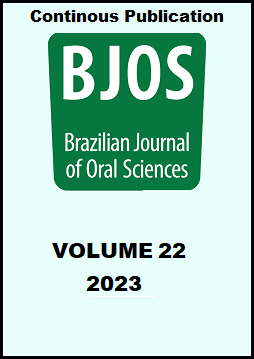Abstract
Evaluate the prevalence of bruxism and to analyze what are the possible associated factors with this condition in students of a Brazilian university. Methods: This was a cross-sectional study, with a sample of 230 students randomly selected among undergraduate courses at a university center. The dependent variable was the presence of awake bruxism and sleep bruxism. The independent variables were sociodemographic factors, smoking, alcohol consumption, oral habits and stress perception (Perceived Stress Scale- PSS 14). Descriptive statistics and bivariate analysis were used. Results: The prevalence of awake bruxism was 28.7% and was associated with the independent variables: course (degree program), gum chewing habits, chin hand placing, facedown sleeping and one-side biting. Sleep bruxism had a 7.0% prevalence and displayed association with gum chewing, pens/pencils/objects biting, tongue/lips/cheeks biting, nails biting and one-side biting. Perceived stress was not associated with either type of bruxism. Conclusion: Bruxism has an important prevalence among university students, especially when distinguishing between awake bruxism and sleep bruxism.
References
Grobet P, Gilon Y, Bruwier A, Nizet JL. [Sleep bruxism : state of the art and management]. Rev Med Liege. 2017 Sep;72(9):410-5. French.
Castrillon EE, Exposto FG. Sleep bruxism and pain. Dent Clin North Am. 2018 Oct;62(4):657-63. doi: 10.1016/j.cden.2018.06.003.
Fluerașu MI, Bocsan IC, Buduru S, Pop RM, Vesa SC, Zaharia A, et al. The correlation between sleep bruxism, salivary cortisol, and psychological status in young, Caucasian healthy adults. Cranio. 2021 May;39(3):218-24. doi: 10.1080/08869634.2019.1619250.
Winocur E, Messer T, Eli I, Emodi-Perlman A, Kedem R, Reiter S, et al. Awake and Sleep Bruxism Among Israeli Adolescents. Front Neurol. 2019 Apr;10:443. doi: 10.3389/fneur.2019.00443.
Lobbezoo F, Jacobs R, DE Laat A, Aarab G, Wetselaar P, Manfredini D. [Chewing on bruxism: associations, consequences and management]. Ned Tijdschr Tandheelkd. 2017 Jul;124(7-8):369-76. Dutch. doi: 10.5177/ntvt.2017.07/08.16195.
Jadhao VA, Lokhande N, Habbu SG, Sewane S, Dongare S, Goyal N. Efficacy of botulinum toxin in treating myofascial pain and occlusal force characteristics of masticatory muscles in bruxism. Indian J Dent Res. 2017 Sep-Oct;28(5):493-7. doi: 10.4103/ijdr.IJDR_125_17.
Shetty S, Pitti V, Satish Babu CL, Surendra Kumar GP, Deepthi BC. Bruxism: a literature review. J Indian Prosthodont Soc. 2010 Sep;10(3):141-8. doi: 10.1007/s13191-011-0041-5.
Cavallo P, Carpinelli L, Savarese G. Perceived stress and bruxism in university students. BMC Res Notes. 2016 Dec;9(1):514. doi: 10.1186/s13104-016-2311-0.
Faro A. [Confirmatory factor analysis of the three versions of the Perceived Stress Scale (PSS): a population study]. Psicol Reflex Crit. 2015;28(1):21-30. doi:10.1590/1678-7153.201528103.
Luft CD, Sanches Sde O, Mazo GZ, Andrade A. [Brazilian version of the Perceived Stress Scale: translation and validation for the elderly]. Rev Saude Publica. 2007 Aug;41(4):606-15. Portuguese. doi: 10.1590/s0034-89102007000400015.
Pontes LDS, Prietsch SOM. Sleep bruxism: population based study in people with 18 years or more in the city of Rio Grande, Brazil. Rev Bras Epidemiol. 2019;22:e190038. Portuguese, English. doi: 10.1590/1980-549720190038.
Serra-Negra JM, Scarpelli AC, Tirsa-Costa D, Guimarães FH, Pordeus IA, Paiva SM. Sleep bruxism, awake bruxism and sleep quality among brazilian dental students: a cross-sectional study. Braz Dent J. 2014;25(3):241-7. doi: 10.1590/0103-6440201302429.
Wetselaar P, Vermaire EJH, Lobbezoo F, Schuller AA. The prevalence of awake bruxism and sleep bruxism in the Dutch adult population. J Oral Rehabil. 2019 Jul;46(7):617-23. doi: 10.1111/joor.12787.
Manfredini D, Winocur E, Guarda-Nardini L, Paesani D, Lobbezoo F. Epidemiology of bruxism in adults: a systematic review of the literature. J Orofac Pain. 2013 Spring;27(2):99-110. doi: 10.11607/jop.921.
Lavigne GJ, Khoury S, Abe S, Yamaguchi T, Raphael K. Bruxism physiology and pathology: an overview for clinicians. J Oral Rehabil. 2008 Jul;35(7):476-94. doi: 10.1111/j.1365-2842.2008.01881.x.
Johansson A, Unell L, Carlsson GE, Söderfeldt B, Halling A. Gender difference in symptoms related to temporomandibular disorders in a population of 50-year-old subjects. J Orofac Pain. 2003 Winter;17(1):29-35.
Nekora-Azak A, Yengin E, Evlioglu G, Ceyhan A, Ocak O, Issever H. Prevalence of bruxism awareness in Istanbul, Turkey. Cranio. 2010 Apr;28(2):122-7. doi: 10.1179/crn.2010.017.
Mota IG, Ton LAB, De Paula JS, Martins APVB. [Cross-sectional study of the self-report of bruxism and its association with stress and anxiety]. Rev Odontol UNESP. 2021;50:e2021000. doi : 10.1590/1807-2577.00321.
Soares LG, Costa IR, Brum Júnior JDS, Cerqueira WSB, Oliveira ES, Douglas de Oliveira DW, et al. Prevalence of bruxism in undergraduate students. Cranio. 2017 Sep;35(5):298-303. doi: 10.1080/08869634.2016.1218671.
Costa ARO, de Oliveira ES, de Oliveira DWD, Tavano KTA, Murta AMG, Gonçalves PF, et al. [Prevalence and factors associated with bruxism in university students: a pilot cross-sectional study]. Rev Bras Odontol. 2017 Apr./Jun;74(2):120-5. doi: 10.18363/rbo.v74n2.p.120.
Gonçalves LPV, Orlando AT, Simone AMO. [Relationship between bruxism, occlusal factors and oral habits]. Dental Press J Orthod. 2010 Mar/Apr;15(2): 97-104.
Abekura H, Tsuboi M, Okura T, Kagawa K, Sadamori S, Akagawa Y. Association between sleep bruxism and stress sensitivity in an experimental psychological stress task. Biomed Res. 2011 Dec;32(6):395-9. doi: 10.2220/biomedres.32.395.
Giraki M, Schneider C, Schäfer R, Singh P, Franz M, Raab WH, et al. Correlation between stress, stress-coping and current sleep bruxism. Head Face Med. 2010;6:2. doi: 10.1186/1746-160X-6-2.
Jokubauskas L, Baltrušaitytė A, Pileičikienė G, Žekonis G. Interrelationships between distinct circadian manifestations of possible bruxism, perceived stress, chronotype and social jetlag in a population of undergraduate students. Chronobiol Int. 2019 Nov;36(11):1558-69. doi: 10.1080/07420528.2019.1660356.

This work is licensed under a Creative Commons Attribution 4.0 International License.
Copyright (c) 2022 Layla Beatriz Barroso de Alencar, Ismael Lima Silva , Samara Crislâny Araújo de Sousa, Vitória Freitas de Araújo, William Harvey Machado de Sousa Lacerda Oliveira, Cristiano Moura


